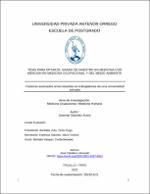| dc.contributor.advisor | Caballero Alvarado, José Antonio | |
| dc.contributor.author | Sánchez Arana, Josemar | |
| dc.creator | Sánchez Arana, Josemar | |
| dc.date.accessioned | 2023-12-06T22:19:23Z | |
| dc.date.available | 2023-12-06T22:19:23Z | |
| dc.date.issued | 2023 | |
| dc.identifier.uri | https://hdl.handle.net/20.500.12759/13872 | |
| dc.description.abstract | Identificar la prevalencia y factores asociados al tecnoestrés en trabajadores de una universidad privada de Lambayeque entre noviembre y diciembre del 2022.
Métodos: Se llevó a cabo un estudio observacional, analítico y de corte transversal en trabajadores de dicha universidad entre noviembre y diciembre de 2022. Los participantes, seleccionados según criterios específicos, completaron el Cuestionario de Tecnoestrés y el Cuestionario DASS 21. Las respuestas se recolectaron mediante Google forms y los datos se analizaron con SPSS versión 28, aplicando pruebas como Chi Cuadrado y t de student. La muestra evaluada fueron 259 trabajadores (115 docentes y 144 administrativos).
Resultados: La prevalencia de tecnoestrés fue del 55,98%. Las características personales como estar casado (OR=2,45; p<0,001) y tener hijos (OR=3,87; p<0,001) mostraron una mayor incidencia de tecnoestrés. No se encontraron diferencias significativas en relación con la edad, IMC o presencia de DM2. En cuanto a las características laborales, los docentes presentaron mayor propensión al tecnoestrés que los administrativos (OR=2,12; p<0,01). También se detectó una fuerte asociación entre el tecnoestrés y la presencia de depresión (OR=4,83; p<0,001) y ansiedad (OR=2,91; p<0,001).
Conclusión: El tecnoestrés afecta a más de la mitad de los trabajadores de la universidad estudiada, estando influenciado por factores personales y laborales. La identificación de estos factores puede guiar intervenciones para mitigar sus efectos en el bienestar y rendimiento laboral.. | es_PE |
| dc.description.abstract | To identify the prevalence and factors associated with technostress in workers of a private university in Lambayeque between November and December 2022.
Methods: An observational, analytical, and cross-sectional study was conducted among the university's workers from November to December 2022. Participants, selected based on specific criteria, completed the Technostress Questionnaire and the DASS 21 Questionnaire. Responses were collected using Google forms, and the data were analyzed with SPSS version 28, applying tests such as the Chi-square and Student's t-test. The sample evaluated consisted of 259 workers (115 teachers and 144 administrative staff).
Results: The prevalence of technostress was 55.98%. Personal characteristics, such as being married (OR=2.45; p<0.001) and having children (OR=3.87; p<0.001), were associated with a higher incidence of technostress. No significant differences were found concerning age, BMI, or presence of DM2. Regarding work characteristics, educators exhibited a higher propensity for technostress than administrative staff (OR=2.12; p<0.01). A strong association between technostress and the presence of depression (OR=4.83; p<0.001) and anxiety (OR=2.91; p<0.001) was also identified.
Conclusion: Technostress affects over half of the workers at the studied university, with personal and professional factors influencing its incidence. Identifying these factors can guide interventions to mitigate their impact on well-being and work performance. | es_PE |
| dc.description.uri | Tesis | es_PE |
| dc.format | application/pdf | es_PE |
| dc.language.iso | spa | es_PE |
| dc.publisher | Universidad Privada Antenor Orrego | es_PE |
| dc.relation.ispartofseries | M_MED_119 | |
| dc.rights | info:eu-repo/semantics/openAccess | es_PE |
| dc.rights.uri | https://creativecommons.org/licenses/by/4.0/ | es_PE |
| dc.source | Universidad Privada Antenor Orrego | es_PE |
| dc.source | Repositorio Institucional - UPAO | es_PE |
| dc.subject | Tecnoestres | es_PE |
| dc.subject | Trabajadores Universitarios | es_PE |
| dc.title | Factores asociados al tecnoestrés en trabajadores de una universidad privada | es_PE |
| dc.type | info:eu-repo/semantics/masterThesis | es_PE |
| thesis.degree.level | Maestría | es_PE |
| thesis.degree.grantor | Universidad Privada Antenor Orrego. Escuela de Postgrado | es_PE |
| thesis.degree.name | Maestro en Medicina Ocupacional y Medio Ambiente | es_PE |
| thesis.degree.discipline | Maestría en Medicina | es_PE |
| dc.subject.ocde | https://purl.org/pe-repo/ocde/ford#3.02.27 | es_PE |
| renati.advisor.orcid | https://orcid.org/0000-0001-8297-6901 | es_PE |
| renati.author.dni | 45034329 | |
| renati.advisor.dni | 18886226 | |
| renati.type | https://purl.org/pe-repo/renati/type#tesis | es_PE |
| renati.level | https://purl.org/pe-repo/renati/level#maestro | es_PE |
| renati.discipline | 912997 | es_PE |
| renati.juror | Bardales Zuta, Víctor Hugo | |
| renati.juror | Espinoza Salcedo, María Victoria | |
| renati.juror | Bardales Vásquez, Cecilia Betzabet | |
| dc.publisher.country | PE | es_PE |




